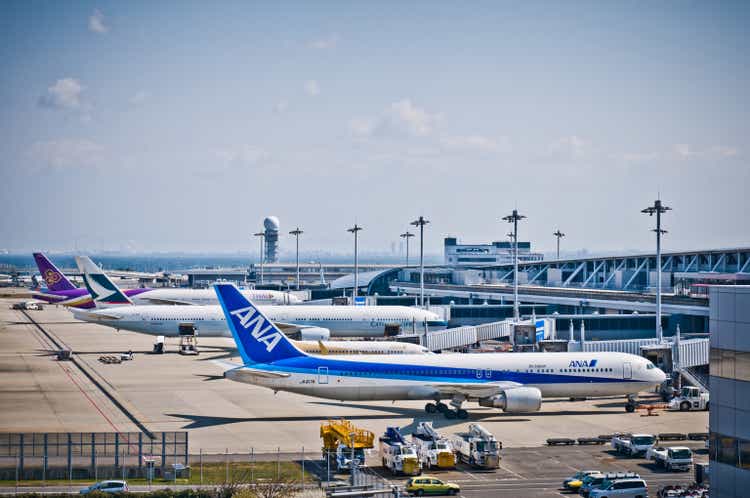
Ghettog76/iStock Editorial via Getty Images In May, I covered ANA Holdings ( OTCPK:ALNPY ) with a strong buy rating. Unfortunately, the stock has not performed well being flat while the S&P 500 gained nearly 2%. On the 30 th of July, ANA reported its first quarter results (quarter ending June 30 th ) and with the most recent results available, I will be analyzing ANA stock including an earnings analysis, risk assessment and a stock price target and rating update.
ANA Holdings Cost Growth Outpaces Strong Revenue Environment ANA Holdings When analyzing ANA’s results, I always include the slide above. It is not the prettiest slide, but it does an extremely good job providing a bridge. Passenger revenues increased 51 billion yen or 12.

1%. ANA International passenger services saw revenues grow by 13.3% on a capacity expansion of 10.
3% showing strong demand in the quarter while ANA domestic passenger services saw revenues increase 6.3% driven by 7.7% higher unit revenues partially offset by 1.
3% lower capacity. Cargo revenues increased 11.3% on positive demand trends, while Peach and Air Japan saw revenues grow by 17.
3% with strength in unit revenues as capacity increased. Total expenses grew by 60.2 billion yen or 16%.
Half of the cost increase was driven by higher fuel and maintenance costs while. While Personnel and contract costs increased 14.3 billion yen and higher landing and navigation fees, sales costs and other costs accounted for the other 25% of cost increase.
Operating income declined 21% to 33.1 billion yen indicating a margin decline from 9.5% to 5.
9% and EBITDA margins decreased from 18.3% to 14.5%.
The chart above might not be the most pretty one, but it really does a good job visualizing the bridge from 2022 to 2023 for operating income. On the revenue level, we see that the revenue growth was primarily driven by growth in international passenger revenues, while lower cargo revenues offset almost all the growth in domestic passenger revenues as well as Peach and Air Japan revenues. Passenger revenue grew 68% on capacity expansion of 48.
5% showing a favorable development in unit revenues. The capacity remained at 77% of pre-pandemic levels, indicating there is significant recovery space ahead. Total operating cost grew almost 18%, providing a favorable amortization profile, resulting in operating margins of 11.
1% compared to 8.1% a year ago. What Are The Risks And Opportunities For ANA Holdings? For ANA, we see strong unit revenues but the unfortunate reality for the airline is that its costs are still rising faster than revenues.
We saw some initiatives boost the domestic business. The company is increasing its low-cost operations with the launch of Air Japan in February this year and cargo unit revenues are finally stabilizing. So, there are good points in the revenue environment, but the cost environment including fuel price fluctuations remains a major pressure item next to higher staff costs.
ANA Holdings Stock: Uncertain Upside For The Stock The Aerospace Forum To determine multi-year price targets The Aerospace Forum has developed a stock screener which uses a combination of analyst consensus on EBITDA, cash flows and the most recent balance sheet data. Each quarter, we revisit those assumptions and the stock price targets accordingly. In a separate blog I have detailed our analysis methodology .
ANA Holdings is probably one of the most difficult airlines stocks I have tried to value. Results are under pressure, despite some pricing initiatives paying off and there is little EBITDA growth in the years ahead. FCF, on the other hand, is expected to trend more favorably and against peer group valuation, there would be 95% upside.
That perhaps shows how beaten down ANA Holdings stock has been coming out of the pandemic. While I certainly do see some risks, I believe that even if we assign half of the upside to the stock price the 47.5% upside remains compelling.
The possible issue is that with the significant pressure on the stock price, it might very difficult to see the upside materialize despite a fundamental support for higher prices. Conclusion: ANA Holdings Is A Speculative Buy ANA Holdings is without doubt seeing cost growth outpacing unit revenue strength and that does not bode well. The stock is significantly undervalued and that provides upside.
So, we see the risks and we see the earnings pressure, but we also see the upside against the peer group valuation. With that in mind, I assign a speculative buy rating on ANA Holdings as it has historically traded at prices that I currently have as the price target but the stock price has not recovered from the pandemic and there is a chance the stock price will have a hard time recovering to those levels even if there is fundamental support for it. Editor's Note: This article discusses one or more securities that do not trade on a major U.
S. exchange. Please be aware of the risks associated with these stocks.
If you want full access to all our reports, data and investing ideas, join The Aerospace Forum , the #1 aerospace, defense and airline investment research service on Seeking Alpha, with access to evoX Data Analytics, our in-house developed data analytics platform. Dhierin-Perkash Bechai is an aerospace, defense and airline analyst. The Aerospace Forum Learn more Analyst’s Disclosure: I/we have no stock, option or similar derivative position in any of the companies mentioned, and no plans to initiate any such positions within the next 72 hours.
I wrote this article myself, and it expresses my own opinions. I am not receiving compensation for it (other than from Seeking Alpha). I have no business relationship with any company whose stock is mentioned in this article.
Seeking Alpha's Disclosure: Past performance is no guarantee of future results. No recommendation or advice is being given as to whether any investment is suitable for a particular investor. Any views or opinions expressed above may not reflect those of Seeking Alpha as a whole.
Seeking Alpha is not a licensed securities dealer, broker or US investment adviser or investment bank. Our analysts are third party authors that include both professional investors and individual investors who may not be licensed or certified by any institute or regulatory body..














